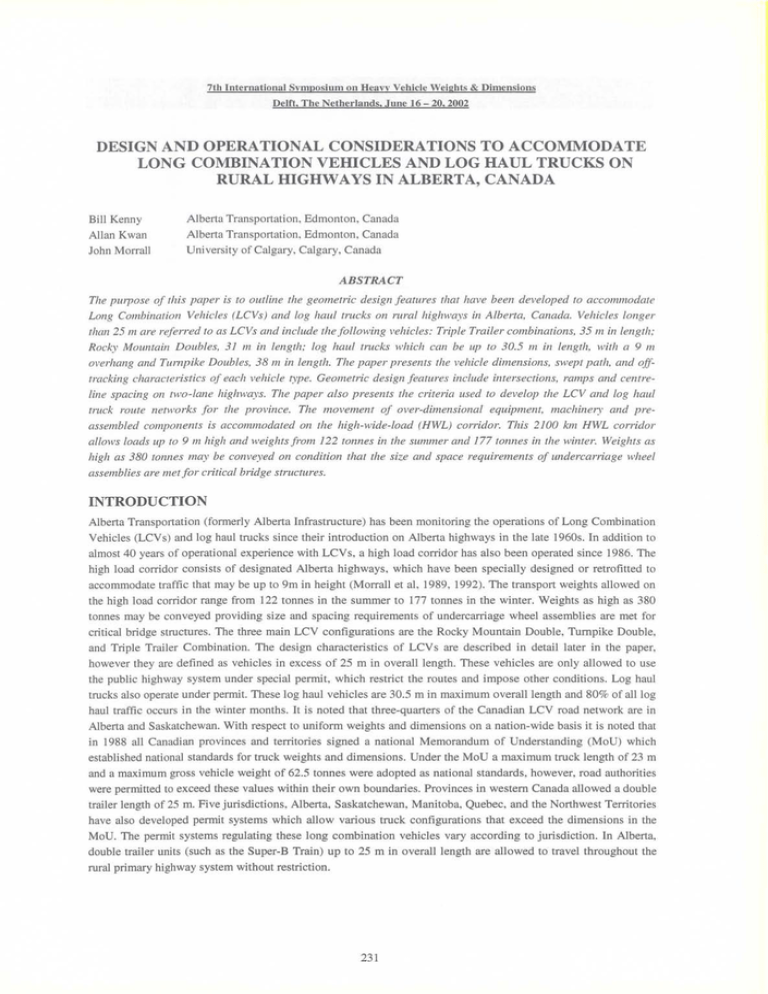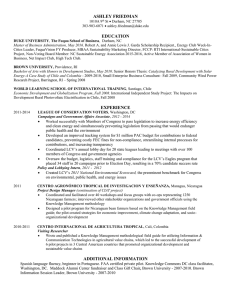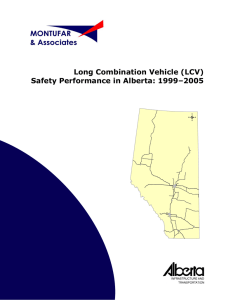DESIGN AND OPERATIONAL CONSIDERATIONS TO ACCOMMODATE RURAL HIGHWAYS IN ALBERTA, CANADA
advertisement

7th International Svmposium on Heavv Vehicle Weights & Dimensions Delet, The Netherlands, .June 16 - 20, 2002 DESIGN AND OPERATIONAL CONSIDERATIONS TO ACCOMMODATE LONG COMBINATION VEHICLES AND LOG HAUL TRUCKS ON RURAL HIGHWAYS IN ALBERTA, CANADA Bill Kenny Allan Kwan John Morrall Alberta Transportation, Edmonton, Canada Alberta Transportation, Edmonton, Canada University of Calgary, Calgary, Canada ABSTRACT The purpose of this paper is to outline the geometric design features that have been developed to accommodate Long Combination Vehicles (LCVs) and log haul trucks on rural highways in Alberta, Canada. Vehicles longer than 25 m are referred to as LCVs and include the following vehicles: Triple Trailer combinations, 35 m in length; Rocky Mountain Doubles, 31 m in length; log haul trucks which can be up to 30.5 m in length, with a 9 m overhang and Tumpike Doubles, 38 m in length. The paper presents the vehicle dimensions, swept path, and offtracking characteristics of each vehicle type. Geometric design features include intersections, ramps and centreline spacing on two-lane highways. The paper also presents the criteria used to develop the LCV and log haul truck route networks for the province. The movement of over-dimensional equipment, machinery and preassembled components is accommodated on the high-wide-load (HWL) corridor. This 2100 km HWL corridor allows loads up to 9 m high and weights from 122 tonnes in the summer and 177 tonnes in the winter. Weights as high as 380 tonnes may be conveyed on condition that the size and space requirements of undercarriage wheel assemblies are met for critical bridge structures. INTRODUCTION Alberta Transportation (formerly Alberta Infrastructure) has been monitoring the operations of Long Combination Vehicles (LCV s) and log haul trucks since their introduction on Alberta highways in the late 1960s. In addition to almost 40 years of operational experience with LCVs, a high load corridor has also been operated since 1986. The high load corridor consists of designated Alberta highways, which have been specially designed or retrofitted to accommodate traffic that may be up to 9m in height (Morrall et aI, 1989, 1992). The transport weights allowed on the high load corridor range from 122 tonnes in the summer to 177 tonnes in the winter. Weights as high as 380 tonnes may be conveyed providing size and spacing requirements of undercarriage wheel assemblies are met for critical bridge structures. The three main LCV configurations are the Rocky Mountain Double, Turnpike Double, and Triple Trailer Combination. The design characteristics of LCV s are described in detail later in the paper, however they are defined as vehicles in excess of 25 m in overall length. These vehicles are only allowed to use the public highway system under special permit, which restrict the routes and impose other conditions. Log haul trucks also operate under permit. These log haul vehicles are 30.5 m in maximum overall length and 80% of all log haul traffic occurs in the winter months. It is noted that three-quarters of the Canadian LCV road network are in Alberta and Saskatchewan. With respect to uniform weights and dimensions on a nation-wide basis it is noted that in 1988 all Canadian provinces and territories signed a national Memorandum of Understanding (MoU) which established national standards for truck weights and dimensions. Under the MoU a maximum truck length of 23 m and a maximum gross vehicle weight of 62.5 tonnes were adopted as national standards, however, road authorities were permitted to exceed these values within their own boundaries. Provinces in western Canada allowed a double trailer length of 25 m. Five jurisdictions, Alberta, Saskatchewan, Manitoba, Quebec, and the Northwest Territories have also developed permit systems which allow various truck configurations that exceed the dimensions in the MoU. The permit systems regulating these long combination vehicles vary according to jurisdiction. In Alberta, double trailer units (such as the Super-B Train) up to 25 m in overall length are allowed to travel throughout the rural primary highway system without restriction. 231 LCV research to date has focused on operational characteristics and highway geometric design improvements to accommodate large trucks. Harkey et a1. (1996) has documented several of the operational characteristics of LCV s believed to have an impact on transportation safety and their relationship to geometric design. These included offtracking, stability, speed, acceleration, braking and stopping distance. Hm·wood et a1. (1999a) identified four specific roadway design elements whose current geometrics may not be adequate to accommodate larger trucks. Those four elements included horizontal curves, curb radii at intersections, curb radii for ramp terminals, and horizontal curves in freeway on-and-off ramps. Harwood's paper demonstrated that substantial costs could be required to accommodate LCV s on the existing roadway system. The costs were sensitive to the type of truck and extent of the roadway system considered. Harwood et a1. (1999b) examined the distribution of the dimensions of roadway elements critical to accommodation of LCV s. These included horizontal curves and grades on mainline roadways, horizontal curves on interchange ramps, and curb return radii for at-grade ramp terminals and intersections. These distributions were critical to assess the adequacy of current road ways to accommodate LCV s and determine the associated roadway reconstruction cost to accommodate larger trucks. Sanderson (1996) has documented the need for cost-effective guidelines to enhance truck safety on Canadian highways. While the focus of his research was on trucks up to 25 m in length it has implications for LCV s. The main cost effective recommendations include the following: • • For intersection maneuverability, longer trucks should be used as the design vehicle if they comprise more than 20% of the turning volume. Adequate sight distances at railway grade crossings are costly and physically difficult to provide for large trucks. • The minimum radius of curvature for freeway off-ramps should be increased given the low rollover threshold of large trucks and resultant collisions. 1. DESIGN VEHICLES, DIMENSIONS, TURNING TEMPLATES, AND ACCELERATION CHARACTERISTICS The basic design vehicle dimensions permitted for the various oversized design vehicles are shown in Fig. 1. Although some vehicles in these groups may be smaller, these dimensions are used for design purposes. Vehicle turning templates have been developed as a design tool to facilitate intersection layout and design of offroad facilities. These templates are produced for various radii to simulate maneuvers that may be made at various speeds. The "medium" turning templates are generally used for design of highway intersections. The load outswing of the log haul truck is a unique feature of this vehicle configuration that requires special treatment in geometric design of log haul intersections. The outswing is due to the long overhang as well as a special telescoping mechanism in the body of the trailer unit. The telescoping mechanism is required to allow the articulated vehicle to turn while carrying a fixed (non-articulated) load. Because of the telescoping mechanism the load of a log haul truck has a much wider sweep than a conventional truck with the same overhang. Data on "acceleration from stop" has been recorded for various vehicle types and is illustrated in Fig. 2. This information is used to determine the design intersection sight distance requirements. 2. LCV ROUTES Alberta Transportation has developed an LCV network (length of 4600 km) on the primary highway system as shown in Figure 3. To date, Triple Trailer Combinations and Turnpike Doubles operate under specific permit conditions that include: 1. Limited to multi-lane highways with four or more driving lanes. 2. Not allowed to operate on statutory holidays or weekends. 232 3. Not allowed to operate during adverse weather conditions or when the highway is icy or heavil y snow 4. covered. No entrance to or exit from Highway 2 may be made except at interchanges, rest area turnouts, or where acceleration or deceleration lanes are provided. 5. Access to and egress from Red Deer is via four-lane roadways only. 6. Where routes fall within a city boundary, the operation of over-length combination units is controlled by the 7. city. Age, experience, and performance of dri ver. 8. Aspects of vehicle performance such as minimum speed. The use of LCV s on two-lane highways in Alberta has recently been evaluated. Barton and Morrall (1998) have set forth traffic volume criteria for LCV use on two-lane highways as shown in Table 1. Maximum traffic volumes for a given percent passing zones with no passing lanes are shown in Table 1. The maximum volumes shown ensure a net passing opportunity (NPO) of 30% or greater. The traffic volume criteria become more stringent as the percentage of passing zones is reduced. For example, the maximum traffic volume below which Rocky Mountain Doubles may operate on a conventional two-lane highway is 425 veh/h for a road section with 100% passing zones. On the same highway, with a 2 km passing lane every 10 km, Rocky Mountain Doubles could operate at traffic levels up to 734 veh/h and still ensure a net passing opportunity of 30%. This indicates that the addition of passing/climbing lanes can be very effective in improving opportunities for passing, virtually doubling the traffic volume level under which LCV s can operate. Assuming rolling terrain with ideal geometrics, a traffic stream consisting of 15 % trucks and 3% recreational vehicles, a traffic volume of 437 veh/h with a 60/40 traffic split defines the limiting traffic volume for level of service C. The maximum volume up to which either of the LCV s qualify to operate on a conventional two-lane highway, so as to ensure a 30% net passing opportunity, is 425 veh/h. Therefore, the traffic volume criteria established from a passing operations point of view are similar to the desired level of service ,which is level of service C, for a two-lane highway in Alberta. 3. LOG HAUL ROUTES Routes for log haul trucks in Alberta are quite changeable due to the nature of the forestry/lumber/pulp mill industries. Hauls that utilize the special log haul truck involve hauling tree length logs from the cut areas to the various mills that process the lumber. The source of logs varies from year to year and may be impacted by external factors such as forest fires and/or unseasonably warm winters. The changeable nature of log haul routes presents a challenge for the highway designer. It is difficult to justify a major capital cost for a short term or temporary haul, however, it is appropriate to provide a fully functional and safe treatment at more permanent locations such as accesses to mill sites. 4. LCV SPECIAL DESIGN CONSIDERATIONS Most of the special design considerations for LCVs relate to at-grade intersections or interchanges. Most of the geometric features and traffic operations characteristics on Alberta' s rural highway system are suitable for high speed operation of LCV s. Where LCVs are allowed to enter an undivided highway by means of a left turn at an at-grade intersection, the design sight distance requirements are theoretically longer than they would be for any other design vehicle. This is due to the greater overall length of LCV s. Although the intersection sight distance model indicates that LCV s may require a sight distance of up to 600 m on undivided highways at a design speed of 110 km/h, observations of gap acceptance in the field indicate that 500 m is acceptable and safe. Where a rural divided highway is being designed to suit LCV operation, the safe access and egress to the highway is again the primary geometric design consideration. Normally in Alberta, divided highway networks are constructed as limited access "expressways" with the ultimate goal of upgrading to "freeway" standards as required in the future to meet traffic demands. Consequently, there are many at-grade intersections on high speed divided highway facilities. Where these intersections are intended to allow LCV crossings, the most practical way 233 to accommodate this operation (with minimal disruption to through traffic) is through the use which will allow refuge for all vehicle types. This can be done at a relatively Iow cost at construction and may also be done as a retrofit on existing di vided facilities as required. centreline to centreline spacing was increased from 30.7 m to 70.0 m to accommodate LCVs at intersection on the Trans-Canada Highway. of a wide median, the time of initial For example, the the Lakeside Road Where LCV s are provided access to divided facilities through interchanges, the layout of all interchange components should be compatible with LCV turning templates and sight distance requirements. 5. LOG HAUL TRUCK SPECIAL DESIGN CONSIDERATIONS As mentioned previously (in Section 2), the load outswing of a log haul truck is unconventional. This unexpected characteristic is potentially hazardous to other road users especially at locations where sharp turns are made such as at intersections. A series of design layouts have been developed to provide the protection needed for the various movements required. In all cases, these intersection design layouts are aimed to prevent encroachment of load outswing onto adjacent lane during deceleration and turning movements. Additional measures taken to accommodate log haul include providing longer sight distance at intersections and providing additional signage 10 advise motorists of the presence of special oversized vehicles. Roadside tumouts are constructed to accommodate drivers to stop, rest and use the facilities , and to provide for vehicle inspection and the tying down of loads. Where log haul routes cross divided highways, wide medians are desirable to allow vehicle refuge in the median. 6. LCVS AND PASSING OPERATIONS The Transportation Association of Canada (TAC) has also investigated the effect of vehicle length on two-lane, two-way roads in Canada (TAC Committee Report 1991). One objective of the study was to determine if current passing sight distances and pavement marking practices are adequate for vehicle lengths of 23 m and 25 m. A key finding was that design passing sight distance (PSD) requirements increase as the length of the impeding vehicle increases. However, the design PSD requirements match well with the standard set by T AC with an operating speed of 80 kmlh and passing maneuvers involving vehicles up to 25 m and a 10 kmlh differential between the design speed and operating speed. At speeds of 90 or 100 kmlh and passing maneuvers involving 23 m or longer vehicles a higher design PSD than that indicated by T AC is required. A conclusion of the T AC technical committee (1991) was "that is not obvious or clear nor is the data available to suggest that a serious problem exists with the performance ofTAC's present barrier line roadway marking and the passing oflong (25 m) vehicles." The T AC study did not consider LCV s. In a recent study of the need to enhance truck safety, Sanderson (1996) has recommended that "minimum passing zone lengths should be increased to at least 300 m from the current 100 m, particularly where legislation requires that a driver not drive to the left of a solid center line." When considering fatal and incapacitating collisions, 6% or more are related to passing maneuvers. Sanderson (1996) also recommended that cost-effective guidelines should also be developed to indicate when the minimum length should be increased due to increased volumes of trucks in the traffic stream. Field observations were made in Alberta (Barton and Morrall 1998) to establish driver behavior when overtaking 30 m Rocky Mountain Doubles. The mean gap size accepted by motorists for overtaking was 17 seconds when impeded by a passenger car, compared to 39 seconds when impeded by a 30 m Rocky Mountain Double. The "impeding" vehicle described here is a vehicle travelling in the same direction as the subject motorist's i.e. not an on-coming vehicle. About 70% of the drivers impeded by the passenger car accepted a gap size of 25 seconds. Compared to this, 70% of drivers accepted a 50 second gap size when impeded by a Rocky Mountain Double. In addition to the actual overtaking time, the "indecision time" or the perception-reaction time involved in the overtaking maneuvers was analyzed. "Indecision time" is the time interval between overtaking vehicle being able to overtake, and commencing to overtake. The field data indicated a mean indecision time of about 3 seconds when overtaking a passenger car, and 8 seconds when overtaking the Rocky Mountain Double. 234 7. SUMMARY Alberta Transportation has been monitoring the operations of LCVs and log haul trucks for more than 30 years. Many roadway geometric design enhancements such as intersection layouts, vehicle turning templates, acceleration and deceleration charactellstics, sight distances, and median spacing and opening have been developed to ensure safe and efficient movements of LCVs and log haul trucks. LCV and log haul routes will continue to expand in Alberta. In this regard, on going monitoring, analysis and research are necessary to validate and enhance LCV and Log Haul geometric design parameters and values. ALBERTA INFRASTRUCTURE. Highway Geometric Design Guide, August 1999. Alberta Infrastructure, Edmonton. BARTON, R.A. and MORRALL, 1. A Study of Long Combination Vehicles on Two-Lane Highways. Transportation Research Record No. 1613. TranspOItation Research Board, Washington D.C., 1998, pp. 43-49. HARKEY, D.L., COUNCIL, F.M. and ZEGEER, C.V. Operational Characteristics of Longer Combination Vehicles and Related Geometric Design Issues. Transportation Research Record No . 1523 . Transportation Research Board, Washington D.C., 1996. pp. 22-28. HARWOOD, D.W., GLAUZ, W.D. and ELEFfERIADOU, L. Roadway Widening Costs for Geometric Design Improvements to Accommodate Potentially Larger Trucks. Transportation Research Board, Washington D.C., 1999a. HARWOOD, D.W., GLAUZ, W.D., ELEFTERIADOU, L., TORBIC, DJ. and McFADDEN, J. Distribution of Roadway Geometric Design Features Critical to Accommodation of Large Trucks. Transportation Research Board, Washington D.C., 1999b. MORRALL, J.F., AB DELWAHAB , W.M., AND WERNER, A. (1989) "Analysis of Traffic Operations for the Movement of Very Large Vehicles on the Edmonton-Fort McMurray High-Wide Load Corridor", Second International Symposium on Heavy Vehicle Weights and Dimensions, Roads and Transportation Association of Canada, Vo1.2. MORRALL, J.F., ABDELWAHAB, W.M ., AND WERNER, A. (1992) "Planning for the Movement of Very Large, Slow-Moving Vehicles", ASCE Journal of Transportation Engineering, Vol 118, No . 3, pp.381-390. SANDERSON, R.W. The Need for Cost- Effective Guidelines to Enhance Truck Safety. Conference Proceedings, Transportation Association of Canada, 1996. TAC Committee Report. The Effect of Vehicle Length on Traffic on Canadian Two-Lane, Two-Way Roads. Committee Report, Transportation Association of Canada, Ottawa, 1991. 235 l.tH~~·· mg~RI$. Table 1 - Maximum Traffic Volume Criteria for LCV Use on Two-Lane Highways Percent Zones Passing Maximum Two-Way Traffic Criteria With No Passing Lanes Rocky Double Mountain Level 50% 60% 70% 80% 90% 100% 102 180 245 299 346 388 425 Maximum Two-Way Traffic Level (veh/h) Criteria With 20% Passing Lanes Turnpike Double and Tri pIe Trailer Rocky Double 166 149 277 91 162 309 411 490 10% 20% 30% 40% (veh/h) 219 268 554 608 655 310 347 381 697 734 236 Mountain Turnpike Double and Triple Trailer 368 438 496 545 587 624 658 TRI PLE TRAILER COrV1Blr~AT I~)~J (WB-33 ) j4--- 8.6m ~ j4--- 8.6m -------+1 j4--- 8.6m -------+1 T 1 1i@~--------- 35m ROCKY MOUNTAl r~ DOU BLE + 4.15m 2.6m WIDTH T 2.6m WI DTH -------------.:~~.I (WB - 28) I ~--~ 16.2m -------.:!: ~~I j4--- 8.5m -------+1 4.15rn 1 1"*"- @(- - - - - - - 3Im TURNPIK E DOU BLE + (WB-36) 14_-"1- - - 16.2m ---~~I !"4~--- 16.2m -------'~~-;.I 111 ~~~~lI~~~-W-B-12.-5m-M-~-.~--~~~~-12.5m-M~-.~--~ I ~~--------I@ 38 m ---------~*'I ALBERTA LOG HAUL TRUCK** l Figure 1 - Design Vehicle Dimensions 237 2.6m 1/i.l DTH 21 20 / 19 / 18 17 16 Cl) 0 Z 15 0 0 W 14 Cl) Z +-' 13 W ::E ..... 12 Z 11 0 ..... « a:: 10 W --1 W 9 0 0 « 8 7 6 5 4 10 15 20 25 30 35 40 45 50 55 60 65 70 75 80 85 90 9.5 100 S = DISTANCE TRAVELLED DURING ACCELERATION IN METRES Figure 2 - Data on Acceleration from Stop 238 AIOOrra 'IlIA.aRlATIDN PROVINCIAL PRIMARY HIGHWAY SYSTEM LEGEND AUGUST1a -*38 metrea maximum overaJllength = 31 mllrll maximum ovaraIlllngIh 1..- _.II_bII . . t.mE: *".Id tIIIltrlll ~ pIInfng thllllllllmlll1 dawIbII an1hel8 MUIIII _ _ t.....ba1118 ttw .... 3Im 1lIUH.-I kw . . . PIIIPDHIo 1II . . . Figure 3 - Alberta's LCV Network on the Primary Highway System 239 240







